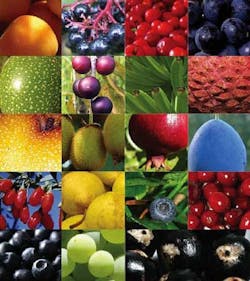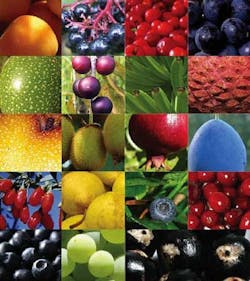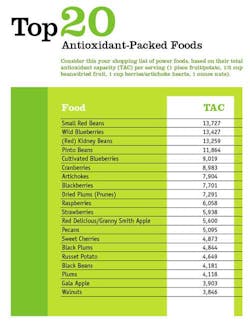Antioxidants: effect on the oral cavity
Research has revealed a link between the health of oral tissues and overall systemic health. Maintaining a good balance of oxidants and antioxidants is important for oral health as well as systemic health.(1) Factors such as pollutants, alcohol, nicotine, hydrogen peroxide, and dental compounds and procedures can disturb the balance of oxidants in oral tissues, causing oxidative stress. Antioxidants can help to offset the imbalance. There are several thousand antioxidants, including enzymes, vitamins, minerals and other nutrients and compounds. Some antioxidants are produced within the body; others, such as vitamins A and C, must be provided by external sources. A healthy, varied diet rich in fruits and vegetables, whole grains, and nuts is an excellent source of antioxidants. Antioxidants may be supplied by other external means as well.(1) Here are some antioxidants and good food sources:(2)
Vitamin C - Citrus fruits and their juices, berries, dark green vegetables (spinach, asparagus, green peppers, Brussels sprouts, broccoli, watercress, other greens), red and yellow peppers, tomatoes and tomato juice, pineapple, cantaloupe, mangos, papaya and guava.Vitamin E - Vegetable oils such as olive, soybean, corn, cottonseed and safflower, nuts and nut butters, seeds, whole grains, wheat, wheat germ, brown rice, oatmeal, soybeans, sweet potatoes, legumes (beans, lentils, split peas) and dark, leafy green vegetables.Selenium - Brazil nuts, brewer’s yeast, oatmeal, brown rice, chicken, eggs, dairy products, garlic, molasses, onions, salmon, seafood, tuna, wheat germ, whole grains and most vegetables.Beta Carotene - Variety of dark orange, red, yellow and green vegetables and fruits such as broccoli, kale, spinach, sweet potatoes, carrots, red and yellow peppers, apricots, cantaloupe and mangos.
Research has also shown that antioxidant molecules only work on specific free radicals or in one area or tissue type. As well, certain combinations of antioxidants can work together synergistically for even greater impact. There is an informational fact sheet about the connection between antioxidants, dental health, and systemic health.(3) While we are familiar with antioxidants taken systemically, such as foods and vitamin supplements, topical antioxidants may have an effect on oral cells. The success of topical antioxidants on skin cells suggests perhaps a similar effectiveness of topical compounds on cells in the oral cavity. Research studies are currently under way to examine the effectiveness of combinations of antioxidants applied topically to oral cells. Results from clinical studies, though incomplete, are positive. In addition, published research studies confirmed that antioxidants that work on skin cells also have an effect on oral, gingival, and periodontal cells.(4,5,6) These studies show how combinations of antioxidants reverse the inhibitory effects of nicotine on wound-healing associated cell migration, how nicotine impairs migration of gingival and periodontal fibroblasts, how treatment with combinations of antioxidants showed synergistic effects in restoring cell migration after wound creation, and how antioxidants may have beneficial effects on regulating fibroblast proliferation during gingival healing or periodontal repair. There is also a literature review on Reactive Oxygen Species (ROS) and antioxidant defense mechanisms in the oral cavity, with 76 references.(7) You may recall, in January of 2012 we published Emerging indications: antioxidants for periodontal disease by Edward P. Allen, DDS, PhD.(8) Dr. Allen discusses how treating periodontal disease will continue to depend on antibiotics for micro-organisms, and how enhancing natural salivary antioxidants with topical antioxidants on oral tissues shows promise in reducing free radicals, oxidative stress and oral inflammation. Dr. Allen shows how in periodontitis and other oral inflammation, topical antioxidants are taking their place next to antibiotics. Read his case study on Post-Surgical Comparisons of Antioxidants vs. Chlorhexidine.(8)
Edward Allen, DDS, PhD, received his DDS from Baylor College of Dentistry in 1969. He completed a Residency in Periodontics and earned a PhD in Physiology from Baylor University Graduate School. Dr. Allen is Adjunct Professor in the Department of Periodontics at Baylor College of Dentistry and is in full-time private practice in Dallas, Texas.




